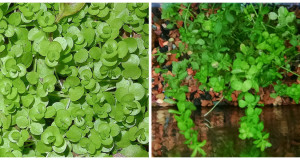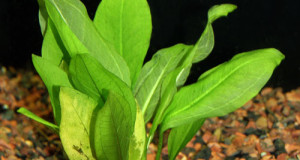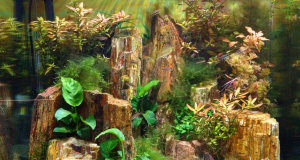Going Green
Patty here. In today’s world, where we’re increasingly buying green, thinking green and living green, a green, lush planted aquarium may be just the thing to give a little perspective. Planted aquariums can be quite rewarding, a relaxing indoor view to the serene underwater world. Now, facing the doldrums of the upcoming winter season it may be the perfect time to create a tropical getaway in your living room. A beautiful green planted paradise can give the room an ethereal and comforting glow, just the aesthetic therapy to ward off cabin fever till spring.
 Your pleasures aside, a planted aquarium has tons of benefits for the fish that reside in the tank too! I’ve always thought that a thriving planted aquarium makes for happier, healthier fish. A successful planted tank gives fish and inverts an environment close to nature, with more natural processes maintaining key aspects that keep the fish in good health.
Your pleasures aside, a planted aquarium has tons of benefits for the fish that reside in the tank too! I’ve always thought that a thriving planted aquarium makes for happier, healthier fish. A successful planted tank gives fish and inverts an environment close to nature, with more natural processes maintaining key aspects that keep the fish in good health.
To start with, live aquarium plants are a natural means of filtration. Non-planted tanks require powerful and efficient means of filtration, whether you prefer canister filters, power filters, undergravel or any other type, these filters and the bacteria they harbor are charged with the duty of removing and breaking down all of the crud produced by the fish and their keepers (usually by means of overfeeding or poor maintenance habits). Unfortunately, tanks and filters without regular maintenance may not be able to maintain the balance on their own. In a well-planted tank, the plants serve as chemical and biological filters, removing and processing many of the toxic components produced by decaying waste, and serving as colonizing surfaces for beneficial bacteria. All that is necessary is a simple mechanical filtration system with a bit of biological media as a back-up. No more chemical solutions to detoxify and neutralize all those nasty toxins! By the active processing of these leftover nutrients in the water, there is little left to benefit algae growth. A planted tank with balanced nutrient and light levels will need very infrequent algae maintenance needs if at all.
As in nature, plants produce oxygen through photosynthesis, so as long as your fish population isn’t too high, you shouldn’t need air stones or the pumps they require to complicate you set-up. One less thing to plug in and fiddle with and your fish will still have all the oxygen they need.
 A jungle of aquatic vegetation provides necessary cover for fish that are accustomed to dense areas of freshwater waterways. Small and timid fish will benefit from the safety and security of lush live plants, and if you’re lucky enough to have fish spawn in the aquarium, the foliage is the perfect nursery for the little guys to find cover too. As a bonus, many fish will eat bits of algae and dead plant bits in the aquarium. For the most part this nibbling will benefit the fish and the plants, the fish varying their diet while allowing the healthy plant tissue to thrive. Of course, you’ll need to be choosy about the fish that you house in a planted tank, as some are strictly herbivores and may destroy and uproot plants.
A jungle of aquatic vegetation provides necessary cover for fish that are accustomed to dense areas of freshwater waterways. Small and timid fish will benefit from the safety and security of lush live plants, and if you’re lucky enough to have fish spawn in the aquarium, the foliage is the perfect nursery for the little guys to find cover too. As a bonus, many fish will eat bits of algae and dead plant bits in the aquarium. For the most part this nibbling will benefit the fish and the plants, the fish varying their diet while allowing the healthy plant tissue to thrive. Of course, you’ll need to be choosy about the fish that you house in a planted tank, as some are strictly herbivores and may destroy and uproot plants.
I can’t really think of any way you can go wrong with a planted aquarium. By far, the benefits outweigh the few minor drawbacks. The maintenance will be about the same if not less than a fish only aquarium. The cost of set-up may be a little more expensive, but you’ll be rewarded once the tank is established, thriving and basically balancing itself and your fish will be very appreciative.
Ready to Garden?
When you’re ready to build your new set-up or upgrade your plastic paradise to something phenomenal, you’ll have to first consider the basics. First, take a look at the aquarium and associate yourself with what you have to start. What are the tank measurements, especially depth? What are the specs of your current lighting, heaters, and filtration? If you’re just starting out, you’ll just want to consider where your tank will be settled then make your shopping list. Your best bet is to start with a tank of at least 30 gallons, and not too tall (under 20″), for the best light penetration.
Once you’ve decided on the aquarium, you’ll want to look for suitable aquarium lighting. There are several aspects to consider here, including aesthetics, functionality and economics. There are many fixtures and lamps available in the market, and with a little research or help from an informed salesperson, you’ll be able to find lighting to suit your individual needs. Without exploring the technical complexities of lighting, you’ll basically need to be looking for lighting that will suit the biological needs of your plants, allowing them to photosynthesize efficiently, thus optimizing their health and growth. The quality of the light is vital. I would suggest that you forget about incandescent, halogen, halide, and skip right to full-spectrum fluorescent lighting. Full-spectrum and compact fluorescent lamps will provide the best quality lighting for a planted set-up and it is the most economical to run and replace, the biggest bang for your buck in the long run. Look for bulbs with full-spectrum bulbs with at least 5000K. You’ll have to consider the depth of your tank, the amount of surface agitation, and you may need to adjust the amount of light up or down depending on other aspects of your aquarium, but as a general rule of thumb, start with at least 2 watts of light energy produced per gallon. This amount may need to be doubled or more depending on various conditions and species of plants you want to keep.
You may also want to pick up a aquarium light timer for the light fixtures. This will allow you to maintain the necessary light-dark cycle. Set the timer for a 8-14 hour daylight period, depending on the lighting and plants you choose, and the lights will automatically turn on and off for the duration. Prolonged periods of dark or light will have a negative impact in aquatic plant life, more light is not necessarily beneficial, and prolonged dark cycles will be detrimental.
Check back on Friday for the conclusion of this article,
Until then,
Patty
 That Fish Blog – Aquarium Advice and Information
That Fish Blog – Aquarium Advice and Information




Yikes! I wouldn’t set a 12-16 hour daylight period unless you’re ready to deal with nasty outbreaks of green-water and other algaes. If you look at where most of the plants used in a planted tank come from (rivers inside rain-forests), you’ll see that the direct-sunlight photo-period is actually quite short. I would say 12 hours would be the max.
Also, there are some pretty amazing inaccuracies in the article with respect to lighting. Before you buy any lighting, make sure you know the difference between “intensity” and “temperature” (5000K is not a measure of intensity).
Also, the light energy and the wattage of a fixture (while related) are not the same thing. Some forms of lighting create much more light energy per watt (a measure of electrical energy consumed by the fixture). Bottom line: go google aquarium lighting for planted aquariums and get informed before you pick a fixture.